Are you a Quiet Speculation member?
If not, now is a perfect time to join up! Our powerful tools, breaking-news analysis, and exclusive Discord channel will make sure you stay up to date and ahead of the curve.
Modern is full of great creatures. A Goyf by any other name is still a Goyf. And yet, no other Modern creature commands as notoriously high a price tag. As of right now, MTGGoldfish's data lists Tarmogoyf as Modern's number-one most-played creature. The first time I read Tarmogoyf myself, after a multiple-year Magic hiatus in 2009, I didn't understand how or why this apparently-vanilla creature was finding its way into Standard Top 8s, Legacy combo decks, and bulletproof pawn shop display cases alike.
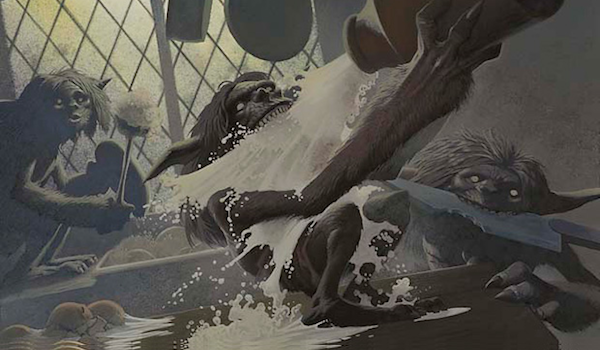
That was seven years ago. I can now tell you why Tarmogoyf is so good. Today, we'll look at the requirements for playability in Modern by analyzing a list of the format's top 50 most-played creatures.
[wp_ad_camp_1]
Data Collection
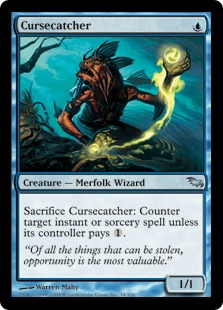 To gather data for this article, I merely wrote down Modern's top 50 most-played creatures, as listed by MTGGoldfish last Tuesday, and sorted the creatures to fit my purposes. Since Tuesday, the data has shifted a bit---some Abzan Company staples like Sin Collector have fallen off the list, making room for Merfolk mainstays like Cursecatcher---but these shifts are natural given a live metagame. I decided to work with my Tuesday data for this article, since I've worked with those numbers more, and the principles in play apply to both lists. It would also be futile to try "catching up" to such protean data---by next Monday, the list will surely have changed again.
To gather data for this article, I merely wrote down Modern's top 50 most-played creatures, as listed by MTGGoldfish last Tuesday, and sorted the creatures to fit my purposes. Since Tuesday, the data has shifted a bit---some Abzan Company staples like Sin Collector have fallen off the list, making room for Merfolk mainstays like Cursecatcher---but these shifts are natural given a live metagame. I decided to work with my Tuesday data for this article, since I've worked with those numbers more, and the principles in play apply to both lists. It would also be futile to try "catching up" to such protean data---by next Monday, the list will surely have changed again.
Sorting the Creatures
Our resident statistician can tell you raw data is useless if it isn't properly organized. There are lots of ways to break up a list of 50 creatures, but since we're considering their playability, I've organized it based on removal resiliency and additional effects. I then grouped the creatures into larger sections by mana cost. As we're working with lists, I've added numbers to the end of each card to indicate its ranking. For example, "Tarmogoyf (1)" indicates that Tarmogoyf is the most-played creature in Modern.
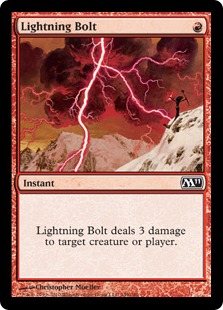 Resisting Removal
Resisting Removal
MTGGoldfish also keeps an index of most-played spell cards on hand. Both on Tuesday and today, that 50-card list contains just five* removal spells:
- Lightning Bolt (1)
- Path to Exile (2)
- Abrupt Decay (15)
- Terminate (29)
- Dismember (42)
*Lightning Helix and Searing Blaze also make the list, but as strictly worse Bolts in terms of removal, I’ve excluded them from this section.
Lightning Bolt and Abrupt Decay, the most flexible removal spells of the bunch, are also the easiest to get around. As such, we can talk about these spells in terms of "tests": creatures with 4+ toughness pass the Bolt Test, and creatures that cost more than three pass the Decay Test. To survive Path to Exile or Terminate, creatures need rare keywords like protection from white or hexproof; given the difficulty of such a feat, I see no need to outline something like a "Path Test."
It's no wonder Path comes in at number two on the spells list, since it cleans up so much for just one mana. Dismember, too, kills almost everything for one; in a format with Burn as the number-two most-played deck, though, it's unsurprising we don't see more of it.
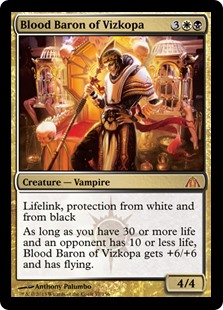 Interestingly, none of the fifty creatures on this list survive Path to Exile, Terminate, or Dismember (except for one, which ignores all five removal spells!), although such creatures do exist in Modern.
Interestingly, none of the fifty creatures on this list survive Path to Exile, Terminate, or Dismember (except for one, which ignores all five removal spells!), although such creatures do exist in Modern.
Blood Baron of Vizkopa is my favorite example. This guy dodges every one of Modern's top removal spells, and has lifelink to boot! Cards like Baron (i.e. Stormbreath Dragon) don't see much play because of the format's blistering nature. There are plenty of matchups in Modern where dodging removal just doesn't matter, like Ad Nauseam and Grishoalbrand. In these matchups, the game is won or lost around turn four, so ripping five-drops basically equates to skipping draw steps. It also doesn't help the Baron's case that Tarmogoyf totally dwarfs him in combat!
Casting a Spell
Many of the creatures on the list that don't pass the Bolt test cast a spell when they enter the battlefield. For example, Eternal Witness casts Regrowth, and Sin Collector casts Duress (sort of). Along with resistance to Bolt and Decay, the ability to cast a spell on resolution is the other metric we'll use to determine creature playability in Modern.
With the formalities out of the way, let's move on to analyzing Modern's creatures. I've excluded the zero-drop creatures, Ornithopter (16) and Memnite (27) from my analysis, as they're simply cogs in Affinity that constitute a sort of outlier.
One-Drops (13/50)
These creatures fail every removal test, but they do so willingly; since none of Modern's top removal spells cost less than one, they're guaranteed to at least break parity with opponents on tempo. None of these creatures cast a spell. Since the bar is so low with one-drops, it's fairly easy for new cards to enter their pool of Modern playables (most recently, we've seen Insolent Neonate in successful decklists, who "becomes" a spell by sacrificing himself). I've sorted these creatures based on their uses across different archetypes. Since many of the decks that want to play a creature on turn one fall under the aggro umbrella, nearly half of the one-drops are combat creatures.
Combat Creatures (5/13)
 Goblin Guide (7)
Goblin Guide (7)- Monastery Swiftspear (10)
- Wild Nacatl (11)
- Kird Ape (37)
- Experiment One (43)
Combat creatures simply attack and block well. Threats like Goblin Guide and Monastery Swiftspear represent the peak of creature efficiency at their mana cost (it's no coincidence these two creatures invariably find themselves in every build of Burn, Modern's most classic aggro deck). One-drop combat creatures from Standard don't often make it in Modern, since they have these best-of-breed staples to contend with.
Synergy Creatures (3/13)
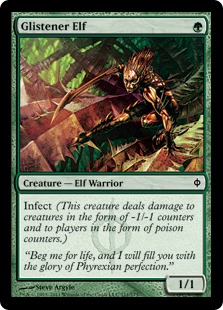 Signal Pest (17)
Signal Pest (17)- Vault Skirge (19)
- Glistener Elf (23)
Synergy creatures each fit into their own decks, and don't easily mesh with other archetypes. Signal Pest can deal far more damage in combat than a single Wild Nacatl when played in the right deck. Vault Skirge (which functionally costs one mana and some life) is an exceptional threat in Affinity, giving that deck the unique ability to turn its board into heaps of life. Glistener Elf was trickier to classify, since it's a straight-up combat creature that only performs in Infect. One-drop creatures with synergy in one of this format's many viable decks can easily transition from prerelease to Modern tournament.
Enablers (3/13)
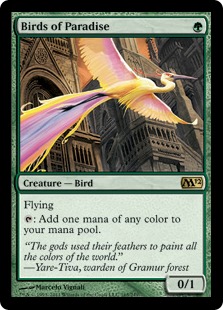 Noble Hierarch (4)
Noble Hierarch (4)- Birds of Paradise (8)
- Viscera Seer (32)
Enablers speed up or empower certain strategies. The enablers on this list have seen tournament play across multiple formats since their release. Wizards has explicitly acknowledged the immense power of starting the game one mana ahead of opponents, and even vowed not to print any more one-mana dorks the likes of Birds and Hierarch for Standard.
As such, it's rare to see generic enablers from Standard break into Modern. Seer allows a plethora of creature-velocity decks to exist in the format, such as Abzan Company and Esper Rally. It doesn't make the list, but the aforementioned Insolent Neonate is Modern's newest one-mana enabler, combining with Faithless Looting to give Dredge eight ways to dump Golgari Grave-Troll on turn one.
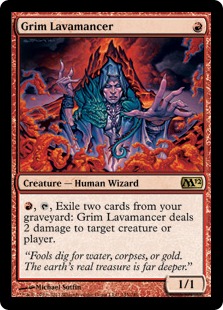 Utility (2/13)
Utility (2/13)
- Grim Lavamancer (31)
- Burrenton Forge-Tender (49)
Utility creatures fill gaps in deckbuilding or address specific problems. They are often relegated to the sideboard. Grim Lavamancer guns down creatures from linear decks like Infect or Affinity, while Burrenton Forge-Tender hoses Modern's aforementioned number-two deck and Anger of the Gods, the most-played sweeper. At just one mana, these creatures are easy includes for archetypes that can benefit from their effects. For new utility creatures to see play in Modern, they need to do something entirely unique, or undercut similar utility creatures on mana.
Two-Drops (23/50)
The bar for playability gets higher as we move up in mana costs. Naturally, a two-drop needs to do more than a one-drop---maybe even twice as much! Modern's two-drops either dodge Lightning Bolt, provide immediate value, greatly bolster a specific strategy, or win the game if unanswered.
Passes the Bolt Test (7/23):
 Tarmogoyf (1) - attacker, blocker
Tarmogoyf (1) - attacker, blocker- Scavenging Ooze (3) - attacker, blocker, utility, hate
- Spellskite (6) - blocker, utility, hate
- Voice of Resurgence (15) - attacker, blocker, hate
- Kor Firewalker (26) - combat, hate
- Wall of Roots (33) - blocker, enabler
- Wall of Omens (44) - blocker, utility
Tarmogoyf excels in battle and nowhere else, but two-drops in Modern often play multiple roles. Scavenging Ooze can enter the fray, hate on graveyards, or gain life; Voice of Resurgence attacks and blocks decently, slows down counterspell decks, and helps out-grind attrition strategies. Two-drops take up the largest portion of this list, clocking in at close to 50%. Since I sort by playability factors for the rest of the article, I’ve added additional classifications to the above two-drops to describe their possible roles. The roles differ based on context---in some decks, like Mono-Green Stompy, Scavenging Ooze primarily attacks and blocks. In others, like Abzan Company, it's a graveyard-hate bullet.
The scarcity of combat creatures at less than three mana that pass the Bolt Test explains Tarmogoyf's throne at the top of Modern's top creatures list. Paying three mana for such a creature opens players up to tempo losses from Abrupt Decay. Just behind Kitchen Finks, Scavenging Ooze comes in at number three on the list for similar reasons. Unlike Goyf, Ooze requires an additional mana investment to grow past Lightning Bolt and excel in combat, but is guaranteed to resist the instant in longer games between interactive creature decks like Jund or Zoo. Granted, Ooze has other strengths---it disrupts graveyard strategies and can sometimes grow bigger than Goyfs---but it differs from Goyf in that it doesn't do any one thing better than all other options at the same mana cost, instead bringing versatility to the table.
Modern's other top Bolt-proof two-drops are enablers and utility creatures. Two-mana dorks in this format can't die to Lightning Bolt, explaining the presence of Wall of Roots and the absence of cards like Deathcap Cultivator. Wall of Omens slows down hyper-aggressive decks without costing a card, and threatens to provide continuous value bursts with other utility creatures like Restoration Angel. Spellskite and Kor Firewalker more deliberately shut down linear aggro strategies, and Voice of Resurgence is one of only three creatures on the list at less than four mana that isn't completely dealt with by Abrupt Decay.
Strongly complements a strategy (10/23):
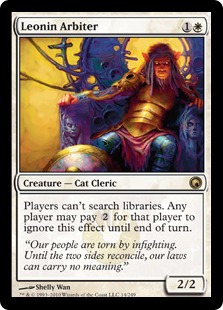 Eidolon of the Great Revel (13)
Eidolon of the Great Revel (13)- Arcbound Ravager (18)
- Blighted Agent (25)
- Thalia, Guardian of Thraben (29)
- Reckless Bushwhacker (35)
- Leonin Arbiter (38)
- Melira, Sylvok Outcast (39)
- Burning-Tree Emissary (42)
- Anafenza, Kin-Tree Spirit (47)
- Lord of Atlantis (50)
These synergy creatures greatly enhance their archetypes, despite dying to Bolt. Death & Taxes couldn't exist without Arbiter and Thalia, and Merfolk wouldn't work without its oldest Lord.
Casts a Spell (4/23):
 Snapcaster Mage (5)
Snapcaster Mage (5)- Sakura-Tribe Elder (20)
- Tidehollow Sculler (30)
- Qasali Pridemage (40)
The difference between Eternal Witness (which casts Regrowth) and Sakura-Tribe Elder (which casts Rampant Growth) is that the Elder trades his own body for the effect, essentially becoming the spell instead of simply casting it. Creatures that cast a spell and leave a body behind cost three mana in Modern, including the flashback-cost-taxing Snapcaster Mage, the most played card in this section because he at least can cost just two mana.
An exception on this list is Tidehollow Sculler, who casts a pseudo-Thoughtseize and lives to tell the tale. Since Sculler gives the card back after dying to a card present in 45% of all Modern decks, the spell he casts is only temporary, making him more of a Meddling Mage than a Thought-Knot Seer and explaining his slumping rank on the list.
Ends the Game If Unanswered (2/23):
- Dark Confidant (9)
- Steel Overseer (21)
Leave these creatures on the battlefield for a couple turns and you're dead meat. Steel Overseer also could have gone in the synergy section, but since his effect is so devastating in Affinity, I chose to put him here. Confidant is much more splashable, earning his status as one of the game's best two-drops. No other creature gives decks spanning multiple archetypes the same kind of inevitability.
Three-Drops (8)
Three-drop creatures in Modern supply pilots with value, often in the form of card advantage. These creatures either resist multiple removal spells or cast a spell.
Passes Bolt and Decay tests (2/8)
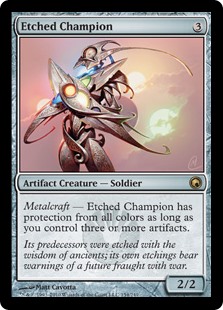 Kitchen Finks (2)
Kitchen Finks (2)- Etched Champion (22)
When it comes to combat creatures, merely passing the Bolt test doesn’t guarantee a three-drop’s playability. Kitchen Finks provides huge bursts of value against aggro decks, synergizes with already-good creatures like Restoration Angel, takes part in an infinite life loop, and grits his teeth through removal spells. He isn’t only featured in Abzan Company—his applications are so broad he makes it into midrange sideboards and mainboards, and comes in just behind Tarmogoyf as Modern’s second-most played creature. Etched Champion only works in Affinity, but he dodges every removal spell in the format with his “protection from all colors” clause, making him the one creature in the top 50 that skirts Path to Exile.
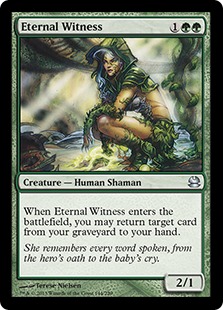 Casts a Spell (6/8)
Casts a Spell (6/8)
- Fulminator Mage (12)
- Eternal Witness (14)
- Simian Spirit Guide (28)
- Flickerwisp (34)
- Wasteland Strangler (46)
- Sin Collector (48)
Modern's three-drops offer pilots the opportunity to cast a spell while putting bodies onto the battlefield. Only Simian Spirit Guide, which is less of a creature and more of a ritual, and Fulminator Mage, whose spell (Stone Rain) costs as much as he does, trade themselves for the effect.
Other Three-Drops
With these principles outlined, we can see why prerelease-hyped creatures like Sin Prodder never make it into Modern. Prodder dies to Bolt and doesn’t immediately cast a spell. He also doesn’t threaten to take over a game, since opponents can choose not to give us the card he reveals. But even if we always drew the card, I don’t think Prodder would see much play. Prophetic Flamespeaker boasts  a superior effect, and Countryside Crusher allows us to draw past extra lands. Neither of those creatures see Modern play, despite outclassing Prodder in combat.
a superior effect, and Countryside Crusher allows us to draw past extra lands. Neither of those creatures see Modern play, despite outclassing Prodder in combat.
One three-drop that does see Modern play, but doesn’t make the list, is Courser of Kruphix. Courser survives Lightning Bolt and provides value over the course of a game, but he doesn't provide immediate value as he enters the battlefield by casting a spell. He also can't take over a game like Confidant; he can just occasionally draw lands if opponents don't find ways to remove him, at the cost of giving opponents perfect information. Modern contains many creatures like Courser that have enough going for them to see some play, but don’t quite make it to staple status.
Four-Drops (4)
Four-drops benefit from an inherent immunity to Abrupt Decay, but with a downside: they often resolve on the turn some Modern games end. The four-drops that make this list all resist Lightning Bolt, cast a spell upon resolution, and boast a special ability.
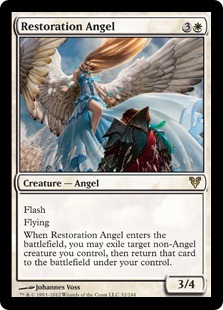 Restoration Angel (24)
Restoration Angel (24)- Thought-Knot Seer (36)
- Obstinate Baloth (41)
- Siege Rhino (45)
Restoration Angel outranks the other four-drops here because of her immense versatility. She casts Cloudshift to provide value with 187 creatures, surprises attackers or gets around countermagic with flash, and applies an evasive clock in the air.
Thought-Knot Seer comes next, casting one of the best spells in Modern—Thoughtseize—to protect himself from relevant removal. Since he dodges Bolt and Decay, Seer will often take an opponent’s only answer, allowing him to bash into the red zone uninhibited. Thought-Knot doesn’t have any extra abilities, but the potent combination of Thoughtseize and Tarmogoyf has kept Jund a Tier 1 deck since Modern’s humble beginnings. This creature combines them on one card. Having his own Sol land doesn't hurt, either.
Obstinate Baloth and Siege Rhino both gain life when they enter the battlefield, but Rhino basically outclasses Baloth on every level with his draining effect, higher toughness, and trample. Baloth only sees more play because it fits into decks like Scapeshift that need the discard insurance and can’t splash a Rhino.
Other Four-Drops
Some four-drops see play in Modern without entirely resisting Lightning Bolt. Since Tuesday, Pia and Kiran Nalaar has jumped up the rankings to the 49 slot. Bolting the parents doesn’t exactly remove them, since they leave two fliers behind. Same deal with Huntmaster of the Fells, who has the added benefit of ending the game if left to his devices for a few turns. Another honorable mention is Kalitas, Traitor of Ghet, who’s become a Jund staple thanks to his adherence to more traditional four-drop values: don’t die to Bolt, apply pressure, and provide value.
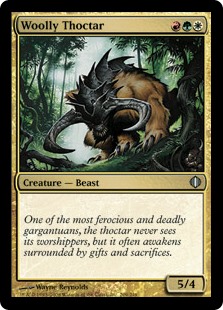 Applying Playability Parameters
Applying Playability Parameters
The parameters for creature playability outlined in this article have widespread utility. I use them to decide whether newly spoiled creatures merit Modern testing, to scour the format’s enormous card pool for sleepers, to examine a deck's positioning in the metagame, and to teach new faces at FNM why Woolly Thoctar isn’t any good. Hopefully, these parameters will do a Kitchen Finks on your Magic experience, and provide you with similar value!




This is a handy reference to have around. I know that I’ll be coming back to it every time I look at a card for the first time and wonder whether it’s good or not. It will probably save me some time (and money) when looking at upgrades for decks or cards to brew around.
Good article.
Worth bookmarking and send to friends who love to hype T2 spoilers as the next big thing in modern.
Good reference for creatures in Modern. A note though, one-drop mana dorks are on hiatus from Standard, not removed forever, according to the article you linked.
Nice catch. What I should have written: “It’s unlikely we’ll see enablers as powerful as Birds and Hierarch enter Standard anytime soon, and therefore very unlikely we’ll ever see enablers that outclass them enter Modern.”
Can you put up just the list at the end of the article, it’d be cool to have it for easy reference. Great article btw!
The list has already changed by now, but a link to the real-time list is in the first paragraph.
Just wanted to say I would love to see more of this type of content. Sometimes it feels like all the online material about Modern (aside from banlist discussion) centers around things like Tier 1 Deck X changing two cards in its list or Tier 1 Deck Y changing its metagame share by half a percent. I’m sure that’s probably relevant to however many pros/aspiring pros are reading (I don’t know your desired or actual audience), but for folks like me who just want to be able to engage the format at a reasonable level when we have a free evening for an FLGS event, the endless micro-analysis of the upper crust gets old fast. I’ve been on the fence lately about whether to bother continuing to check MN on my lunch breaks, as I’m getting the impression I’m not your target audience. Then an article like this comes along, that actually discusses how Modern Magic works (and why) instead of scrutinizing the tiny variations of a small minority’s decades-old decklists, and I wonder if maybe I should stick around.
Even so, perhaps I should just ask directly: If I have no aspirations of getting onto the Pro Tour, am I part of your target audience? Or should I just check the archives every couple of months in case something relevant to me has turned up?
Not sure I can speak for the other writers here, but my target audience is anyone who plays Modern at least semi-competitively. I try to stick to stuff I know a lot about, explaining all my pieces on tempo and combat decks, but this creature article is one I’ve thought about and wanted to write for a long time. I’d like to do related articles in the near future on spells and maybe even utility lands, and some stuff about format speed. If you can think of something broadly Modern-applicable you’d like to read more about, and think I did a decent enough job on this article, don’t hesitate to drop me a line about it!
Editor in chief here. We definitely aspire to cater to a wide variety of Modern enthusiasts—pretty much anyone who loves the format like we do. So your feedback is appreciated, and definitely heard. We’re looking to bring on more writers in the next couple months or so, and hopefully expand our offerings. If I understand you correctly, It sounds like you’re interested in the more qualitative theoretical discussions of Modern. That’s certainly something we will aim to provide (in addition to the quantitative stuff, of course). I hope you’ll stick around!
Thanks for the replies, Jordan and Jason. 🙂
It’s not so much that I’m specifically wanting qualitative data rather than quantitative data; it’s more that once you get past a certain level of precision, the pool of players for whom it matters starts to shrink dramatically. For example, there’s that sidebar with the breakdown of the current metagame. Great! Now anybody looking to play some Modern can see what’s out there and make decisions based on that information. However, the additional precision afforded by expanding that metagame breakdown into an entire article is only relevant to a pretty particular subset of players. Nothing wrong with that kind of content, mind you; back in my Standard days I was tuning my decks week to week and the slightest metagame shift was relevant to me. But that’s not where I am now, and so that type of content has lost its relevance to me (and to those like me, whatever portion of the audience they may comprise).
Perhaps in practice this might mean that the content I’ll enjoy most and the content that’s more qualitative than quantitative are virtually identical sets. That’s fine. The point is that articles which can apply to a wide range of player types seem like a good idea. This creature breakdown article, for instance, can be helpful for a PTQ grinder looking for candidates for that last flex spot, but can also be helpful for the $10/month budget player desperately digging through commons boxes in an effort to cobble together something not shame-worthy, and can serve anyone in between.
I’m definitely in favor of you continuing to include content that’s only relevant to high-level competitors. Just… maybe keep an eye on what percentage of your total content is relevant to what percentage of your total playerbase. 🙂
In other news, the smiley-face icon doesn’t look very happy, apparently.
Author doesnt understand the main idea of cards popularity
Card (creature for this article) is as popular as decks that play it
A creature can’t be good or bad. If a creature fits into certain deck, the deck is popular, then creature gets to top50 chart, not because its good.
If you disagree with me then tell how comes Deceiver Exarch and Eldrazi Mimic were on this list but then disappeared, did they lose their abilities? Eldrazi Temple was printed 7 years ago but skyrocketed into top50 only this january, did wizards change its text so it became more powerful?
‘[…Confidant is much more splashable, earning his status as one of the game’s best two-drops. No other creature gives decks spanning multiple archetypes the same kind of inevitability.’ That is some high praice. Wonder where Ruin Raider is on the radar.
Once the opponent taps out any GBX deck, or WB Death and Taxes, can garantee to sett up a card draw. I would love to see this article updated to take Fatal Push into consideration, and include the new creatures like Tierless Tracker and Ruin Raider.
Raider costs 3. Update article is definitely in the works; just waiting for the metagame to settle a bit more.
Great to hear. I would like to hear a breakdown between the 3 removal spells. There are also some exciting new creatures.
Keep up the good work. 🙂